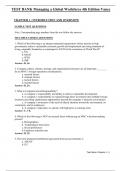TEST BANK Managing a Global Workforce 4th Edition Vance
CHAPTER 1 : INTRODUCTION AND OVERVIEW
SAMPLE TEST QUESTIONS
Note: Corresponding page numbers from the text follow the answers.
MULTIPLE CHOICE QUESTIONS
1. Which of the following is an intergovernmental organization whose mission to help
governments achieve sustainable economic growth and employment and rising standards of
living, originally founded as a counterpart to NATO at the conclusion of World War II?
a. UN
b. OECD
c. WTO
d. IMF
Answer: B, 16.
2. Company culture, climate, strategy, and organizational structure are all important ________
for an MNC’s foreign operations considerations.
a. external factors
b. strategic factors
c. tactical factors
d. internal factors
Answer: D, 24.
3. What is Corporate Social Responsibility?
a. A company’s responsibility and ability to achieve sustainable development
b. A company’s responsibility to expand foreign direct investment into multiple foreign
locations, providing employment opportunities beyond the company’s domestic environment
c. A company’s awareness of the need of ethical attention toward the environment, its
community, and its employees
d. A company’s imperative to operate with high price to earnings ratio
Answer: C, 7-8.
4. Which of the following is NOT an external factor influencing an MNC’s decision-making
process?
a. Demographics
b. Technological innovation
c. Social preferences
d. Employee retention rate
Answer: D, 25.
5. The most integrated multilateral agreement between governments is
a. ASEAN
b. EU
Test Bank Chapter 1-1
, c. MERCOSUR
d. OECD
Answer: B, 11.
6. MERCOSUR is a multilateral agreement among which countries?
a. Malaysia, Indonesia, and Vietnam
b. Germany, France, and Italy
c. Oman, UAE, and Saudi Arabia
d. Argentina, Brazil, and Uruguay
Answer: D, 11.
7. The ILO’s Declaration on Fundamental Principles and Rights at Work did NOT cover which
of the following areas?
a. Freedom of association and the right to collective bargaining
b. Fair import and export tariffs
c. The elimination of forced and compulsory labor
d. The abolition of child labor
Answer: B, 16.
8. Labor unions, and employer and professional associations are examples of ________.
a. Non-Government Organizations
b. Employee-Interest Organizations
c. Worker Protection Associations
d. PCNs
Answer: B, 19-20.
9. One of the strongest forces today to counter the great global influence of MNCs is the
combined impact of ________.
a. Labor unions
b. World Bank
c. NGOs
d. Financial IGOs
Answer: C, 21.
10. Which of the following statements about company culture is NOT true?
a. Company culture is the overall prevailing set of assumptions, attitudes, beliefs, norms,
practices, and value within the organization.
b. Company culture can have powerful influence on behavior of company members.
c. Company culture is relatively easy to change.
d. Company culture has major impact on management thinking patterns and philosophy.
Answer: C, 25.
11. Which of the following is a fundamentally important priority for MNCs?
a. Aligning workforce management practices and human resource functions with
company strategy.
Test Bank Chapter 1-2
, b. Changing company culture periodically to provide change and variety in the work
environment to maintain employee interest and satisfaction.
c. Measuring company climate every quarter to ensure appropriate fit.
d. Downsizing and running “lean” to optimize efficiency and productivity.
Answer: A, 3-4.
12. Strategic Management should involve the identification of ________.
a. employee individual weaknesses
b. core company values and competencies
c. MNC’s corporate responsibility liabilities
d. outsourcing opportunities in politically unstable areas
Answer: B, 26.
13. Institutions should acquire the following moral responsibilities when it comes to international
human resource management except which of the following?
a. Avoid the semblance of discriminatory treatment.
b. Foster personal enlightenment and self-enrichment of all employees.
c. Embrace the growth of globalization regardless of local trends.
d. Help all employees develop useful, marketable skills.
Answer: C, 32.
14. What is the largest, most comprehensive IGO and global forum in the external environment
of global workforce management?
a. WTO
b. UN
c. EU
d. NAACP
Answer: B, 14.
15. An organization’s international human resource management efforts should take into
consideration
a. all employees at all levels and locations, including contingent workforce members.
b. only regular employees located in the country where the organization is headquartered.
c. only regular (non-contingent) employees of the organization, wherever they are
located.
d. only employees, whether regular or contingent, located outside of the national
boundaries where the organization is headquartered.
Answer: A, 28-29.
16. Action-learning training methods, zero-based human resource forecasting, off-shoring back
office operations, and managing foreign worksite are examples of ________.
a. technological innovations
b. Chaos Theory
c. innovations in management practice
d. globalization effects on HRM practice
Answer: C, 19.
Test Bank Chapter 1-3
, 17. With instant communications facilitated by the Internet and global cell phones and businesses
operating in increasingly multi-national and multi-cultural common capacities, cultures are
experiencing rapid ________.
a. customization
b. decline
c. convergence
d. divergence
Answer: C, 34.
18. When implementation of company plans and objectives has to be adjusted for local
customization, it is an example of the influence of ________.
a. divergence
b. globalization
c. ethnocentrism
d. recapitulation
Answer: A, 35.
19. Which organizational function is increasingly placed in the role of “conscience” of the
organization, holding the responsibility of developing and monitoring the culture and overall
internal environment that support ethical behavior?
a. Community Relations
b. Social Responsibility Function
c. Human Resources
d. Public and Government Relations
Answer: C, 30.
20. World Bank and IMF are examples of ________.
a. NGOs
b. financial IGOs
c. trade unions
d. common markets
Answer: B, 17.
21. The ___ was established in 1999 to bring together important industrialized and developing
economies to discuss key issues in the global economy.
a. G-20
b. G-7
c. G-77
d. WTO
Answer: A, 13-14.
22. This growing international career trend involves self-initiated expatriates from developed
countries going abroad on their own to developing countries and finding new venture
opportunities that can strengthen local economies.
Test Bank Chapter 1-4




